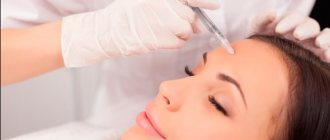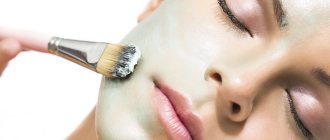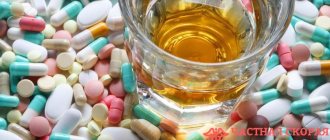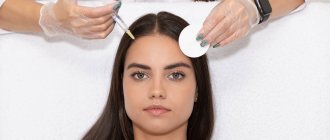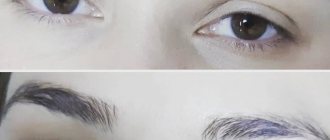Plasmolifting of the face is a rejuvenating and restorative procedure based on the injection of the patient’s blood plasma into the skin.
As a result of plasma lifting, metabolism in the skin accelerates and cell regeneration begins in the treated area. Skin color becomes more even, pores narrow, fine wrinkles disappear, scars do not look as noticeable as before the procedure. The effect of plasma lifting is cumulative and lasts up to six months.
Despite how quickly the skin condition changes for the better after plasma lifting, caring for your face does not end after this procedure. In order for the effect of plasma exposure to last as long as possible, you must follow a few simple rules.
Makeup
After a plasma lifting session, you will have to give up decorative cosmetics for a while. During the procedure, microscopic needles injure the skin, piercing it and leaving wounds invisible to the eye. The entry of bacteria contained in any makeup products into these wounds can cause inflammation, acne and ulcers. Some components of decorative products cause an allergic reaction when they get into small punctures on the face.
Plasma therapy specialists do not recommend using creams, scrubs and lotions for washing until three days have passed since the session.
Dentistry:
50. Can I count on successful dental implantation after plasma lifting? How many procedures are needed in this case?
Can. PLASMOLIFTING accelerates implant survival and stimulates osseointegration processes. In addition, with the help of platelet-rich plasma, implant rejection processes are suppressed. 2 procedures are required. 51. How long does the effect of treatment of periodontal disease and periodontitis last?
1 year. 52. Does plasmolifting improve the healing processes during sinus lifting and bone grafting?
Certainly. It is for these purposes that this method was developed.
Water treatments
There is a constant flow of people in the pool, sauna or bathhouse. Even when the body is in a less vulnerable state than after plasma lifting, in such places there is a risk of becoming infected with easily transmitted diseases - for example, fungus. Bacteria will freely penetrate the skin damaged by microneedles. In addition, chlorine and other cleaning agents that are always present in public pool water can cause an allergic reaction.
Unusually high temperature is the main feature of baths and saunas, and it is dangerous for the patient after exposure to plasma. Warm wounds heal more slowly, making infection even more likely.
It is not recommended to visit all of the listed establishments during the entire plasma lifting course.
The body's reaction to injections
A full course of injections can significantly improve the condition of all systems and organs. But only if you follow the recommendations at the preparation stage and there are no contraindications.
As a result of the administration of platelet-rich plasma, the following occurs:
- Biologically active substances are intensively produced.
- Cell division and regeneration are accelerated.
- The rate of tissue renewal increases.
- Collagen, hyaluronic acid and elastin are produced.
- Blood circulation improves.
- Joint pressure decreases.
Negative reactions include allergies and relapse of chronic diseases. Therefore, if they are present, the procedure is not recommended.
Taking certain medications
During the plasma lifting procedure, the doctor makes many shallow punctures on the skin of the face, so the skin and the body as a whole become much more vulnerable than usual. Before the session, you must tell about all the medications you are taking and carefully follow the specialist’s recommendations. Otherwise, injection of plasma into the skin may cause bleeding or an allergy to medications taken that slow down blood clotting.
Among the medications that are prohibited from taking before a plasma lifting session and during the entire course of procedures are aspirin-based drugs and heparin.
Plasmolifting in aesthetic cosmetology
Plasmolifting is an effective and safe method of regenerative medicine based on the principles of autohemostimulation. Unlike autohemotherapy, plasma lifting uses not the patient’s venous blood, but plasma isolated from it containing platelets [1].
The essence of the plasmolifting method is the injection of platelet plasma according to the principle of mesotherapy into the deep layers of the dermis. The authors of the method, who received a patent in the Russian Federation, are Russian scientists: Doctor of Medical Sciences R. Akhmerov and Candidate of Medical Sciences R. Zarudiy. They were the first to use plasma lifting to restore patients who had undergone maxillofacial surgery [2].
Today, the method is successfully used in cosmetology and trichology, dentistry, orthopedics and traumatology, gynecology, urology and sports medicine.
Human blood plasma is a complex mixture of many biologically active components with different physiological activities. The main components of serum include: plasma proteins (albumin, fibronectin, alpha-2-macroglobulin, fetuin, transferrin, polypeptide growth factors (insulin, insulin-like growth factors I and II (IGF), platelet-derived growth factor (PDGF), epidermal growth factor ( EGF)), glutathione, non-peptide hormones (cortisol, hydrocortisone), estrogens, androgens, thyroid hormones (T3, T4), lipids (linoleic acid, cholesterol, lysophosphatidic acid, prostaglandins); metabolites (amino acids, alpha-keto acids (pyruvate), polyamines), minerals (Fe2+, Zn2+, Cu2+, Mn2+, SeO32–, Co2+, VO3–, Mo+) (HR Maurer, 1986) [4].
The most important functions of blood plasma are provided [4]:
1) factors that stimulate cell growth; 2) factors of attachment and “spreading” (matrix); 3) transport proteins that carry some hormones, minerals, lipids, etc.
Most growth factors are present in blood plasma in very low concentrations (on the order of 10–10 M). Some of them affect only cells of a strictly defined type of differentiation, for example, hematopoietic growth factors. Others have a wide spectrum of action. Epidermal growth factor, for example, stimulates the proliferation of fibroblasts, epidermal and glial cells.
Among the hormones, insulin is the most essential for the growth of almost all cell types in culture. Because it has a short half-life and is sensitive to inactivation by cysteine, it is usually added to the medium in high concentrations.
Glucocorticoids (hydrocortisone, dexamethasone) can stimulate or inhibit cell proliferation in culture depending on the cell type and culture density. They can modulate cell proliferation by altering the response to growth factors.
Some cell lines require special steroid hormones (estradiol, testosterone, progesterone) for growth.
Blood plasma also contains proteins whose function is to bind molecules with low molecular weight. Albumin binds vitamins, lipids (fatty acids, cholesterol), steroid hormones, etc. Iron-saturated transferrin is necessary for most cells in culture, many of which have specific transferrin receptors on the surface [4].
Blood plasma is also a source of various lipids necessary for the survival and growth of cultured cells. Cell lines vary in their requirements for fatty acids, phospholipids, lecithin and cholesterol.
The role of various inorganic elements contained in trace amounts in plasma (Cu, Zn, Co, Mn, Mo, Va, Se) is not fully understood, but it is known that many of them act as cofactors of enzymes. SeO32– is required for the activation of a number of enzymes involved in metabolic detoxification. Selenium is also involved in the inactivation of free radicals.
Thus, the plasma used during the procedure is the human body’s own product, containing many useful substances, and, most importantly, it does not cause rejection reactions or side effects [4]. Thanks to this, plasma lifting is today one of the safest and most effective methods of anti-aging medicine.
The most common procedure involving intradermal plasma injection is facial plasmolifting. Despite the simplicity of the plasma lifting procedure, it is necessary to remember that this procedure is primarily therapeutic and requires an appropriate approach. Firstly, before prescribing it, a consultation with a specialist is required, and standard blood tests are taken. Immediately 2-3 days before the procedure itself, for its effectiveness, the following recommendations should be followed:
- exclude the use of pro- and anticoagulants, as well as medications such as Aspirin or Citramon;
- increase the amount of water you drink (at least 2 liters per day);
- do not drink alcohol, preferably tobacco;
- give up fatty and spicy foods, including chips;
- reduce physical activity.
On the day of the procedure, 3-4 hours before the procedure, do not eat. It is easiest to come on an empty stomach in the morning, so it is better to have a session in the first half of the day [5].
Plasmolifting technique
The technique of plasma lifting [6] is as follows. The procedure begins with taking 10–20 ml of venous blood from the patient into a test tube containing an anticoagulant and separation gel (depending on the manufacturer). Then, using a laboratory centrifuge, the blood is divided into fractions:
1) cellular component (erythrocytes, leukocytes); 2) platelet-rich plasma (about 1 million/μl); 3) platelet-poor plasma (less than 150 thousand/μl).
Platelet-rich plasma is injected into problem areas pre-treated with an antiseptic using microinjection. For pain relief, topical anesthesia (numbing cream) can be used. At the end of the procedure, problem areas are re-treated with an antiseptic.
To prevent side effects, the authors of the method are prohibited from modifying it by adding any other components to platelet-rich plasma, including vitamins and mesotherapy preparations.
The duration of the procedure is 40–50 minutes.
Only in 40% of cases a positive effect is visible after the first procedure. To obtain a pronounced effect, several procedures are necessary.
A standard plasma lifting course includes 4 sessions with an interval of 7–14 days.
To maintain the effect, it is recommended to carry out plasma lifting annually.
The effect of the course can last up to 2 years.
Acne treatment using plasma lifting method
Many years of practice have recommended plasmolifting as an effective remedy for acne [1, 2]. Subcutaneous injection of autoplasma triggers an instant process of cell division. Platelet-derived growth factors stimulate the synthesis of collagen and elastin fibers, which are responsible for the firmness and elasticity of the skin. In tissues, intercellular metabolism accelerates, local immunity increases. As a result, the functioning of the sebaceous glands is normalized, and the skin acquires a beautiful, even color.
Of course, it is necessary to remember that the effect of plasma lifting does not occur immediately. It all depends on the condition of the patient’s skin at the time of visiting the doctor and medical history. You also need to immediately warn the patient that plasma lifting cannot be a monoprocedure in the case of acne treatment, especially severe forms. Additional therapeutic measures will be necessary, such as cleansing, chemical peels, various masks, as well as general therapy in the form of vitamins, microelements and even antibiotics and retinoids, in case of severe pathological skin process.
Plasmolifting and post-acne
Autoplasma injection procedures are also actively used in post-acne therapy [7]. Plasmolifting is usually prescribed in combination with chemical peels and hardware methods for treating problem skin.
Plasmoplasty
Plasmoplasty (ecofiller, plasmafilling, plasma gel, platelet gel, PRP contour plastic surgery) is the introduction of platelet-rich plasma into the skin in the form of a clot, as an alternative to synthetic fillers for contour plastic surgery. The method is not effective enough, since the clot dissolves quickly enough, being absorbed by the tissues; this method cannot yet provide a worthy alternative to synthetic fillers in terms of obtaining a “filling effect”. Subsequent thermal treatment with lasers and RF therapy devices is possible, but does not radically solve the problem [2].
Laser plasma lifting
Laser plasmolifting (laser plasma therapy, laser plasmogel) - these terms may mean:
- The use of platelet-rich plasma in the form of a clot is applied to the skin and treated with laser radiation, which should facilitate the penetration of active substances into the deeper layers of the skin. It should be understood that the “no-injection” nature of the technique in this version is compensated by its significantly lower efficiency.
- Plasmoplasty with subsequent heating of the clot introduced into the skin using a laser to coagulate it.
- The use of hardware techniques (fractional photothermolysis or laser resurfacing) followed by a plasma lifting procedure or the application of blood plasma to laser-damaged skin in the form of a clot. At the same time, the effectiveness of laser techniques increases slightly, and the skin healing period is reduced [5].
Side effects and complications of plasma lifting
Side effects and complications during plasma lifting are also possible [1–3]!
Allergic reactions during plasmolifting are less likely than with most other methods of mesotherapy, however, they are not completely excluded: allergic reactions are possible to medications added to the blood before centrifugation to prevent its clotting, antiseptics, anesthetic creams, as well as to the metals from which they are made needles.
In addition, the appearance of hematomas at the injection sites of the autologous preparation and hyperemia immediately after and within 2–3 hours after the procedure cannot be completely excluded.
An infectious process cannot be ruled out if the rules of asepsis and antisepsis are not followed by the doctor and the patient.
Complications may also include:
- exacerbation of chronic diseases;
- autosensitization;
- rapid fibrosis;
- short-lived result.
Restrictions on plasma lifting
To avoid the development of pigmentation in places where the skin is damaged by a needle, for several days after the procedure you should avoid visiting a solarium, exposure to direct sunlight, as well as visiting saunas and swimming pools.
Expected result with plasma lifting
- Increasing elasticity, moisture, firmness of the skin;
- lightening pigment spots, improving skin color;
- smoothing out fine wrinkles;
- smoothing of scars, stretch marks;
- when applied to the upper part of the head, it reduces dandruff and hair loss.
Indications for plasma lifting
- Age-related skin changes;
- deterioration of skin condition after sudden weight loss;
- gray skin color, age-related elastosis;
- acne, post-acne;
- rehabilitation period after excessive exposure to ultraviolet rays (solarium, natural tanning);
- rehabilitation period after medium and deep peels;
- initial stages of skin ptosis;
- decreased turgor, dry skin;
- dull, sparse hair;
- diffuse alopecia (baldness);
- dandruff;
- stretch marks and scars;
- correction of the unsuccessful effect of botulinum toxin injections.
Contraindications for plasma lifting
- Antiplatelet therapy, use of non-steroidal anti-inflammatory drugs (Aspirin, Analgin, etc.) less than 2 days before the procedure;
- allergy to anticoagulants, heparin intolerance;
- corticosteroid injections less than 14 days before the procedure;
- menstruation;
- pregnancy and lactation;
- oncological diseases;
- hepatitis;
- diseases of the immune system;
- taking antibiotics;
- systemic blood diseases;
- immunosuppressive state;
- platelet level below 100 thousand/µl;
- hemoglobin level below 100 g/l;
- hypofibrinogenemia;
- elevated temperature, fever;
- sepsis, acute infections;
- hemodynamic instability;
- platelet dysfunctions and abnormalities;
- mental disorders;
- exacerbation of chronic diseases;
- infectious diseases.
Thus, the use of the patient’s own autoplasma to correct age-related skin changes has found wide application in aesthetic cosmetology. Today, plasma lifting can be called one of the most popular and fairly inexpensive cosmetic procedures, with a good predictable clinical effect. But there is still one fly in the ointment in this barrel of honey: not a single cosmetologist has reliable data on the long-term results of using autoplasma for cosmetic purposes! Therefore, plasma lifting should be treated as a therapeutic procedure, not a preventive one, and it should only be performed by a specially trained doctor who clearly understands that he is working with a biologically active substance - autoplasma.
Literature
- Akhmerov R., Zarudiy R., Rychkova I., Bochkova O. Plasmolifting (Plasmolifting) treatment of age-related skin atrophy with platelet-rich autoplasma // Aesthetic medicine. 2011. No. 2. T. X. S. 3.
- Akhmerov R., Zarudiy R., Rychkova I., Bochkova O. Achievements of Plasmolifting™ technology: Plasmolifting Gel and Plasmoneedle in facial rejuvenation // Aesthetic Medicine. 2013. No. 4. T. XII. S. 3.
- Akhmerov R., Zarudiy R., Rychkova I., Bochkova O. Plasmolifting™ - treatment of age-related skin atrophy with platelet-rich autoplasma // Aesthetic Medicine. 2011. No. 2. T. X (2). pp. 181–187.
- Tkachenko B.I. Normal human physiology. 2nd ed. M.: Medicine, 2005. 928 p.
- Krebs H. Autohemotherapy M.: Eksmo, 2010. 384 p.
- Akhmerov R., Zarudiy R., Rychkova I., Bochkova O. Identification of KI-67-positive cells in the epidermis and pilosebaceous complex of the scalp before and after treatment with platelet autoplasma // Aesthetic Medicine. 2014. No. 4. T. XIII. P. 555.
- Zarudiy R.F., Akhmerov R.R. Use of platelet-enriched autoplasma for the treatment of photodermatosis // Electronic journal “Regenerative Surgery”, UDC 616.5–085: 615.38, 2005, No. 3.
Z. Sh. Garaeva1, Candidate of Medical Sciences L. A. Yusupova, Doctor of Medical Sciences, Professor G. I. Mavlyutova, Candidate of Medical Sciences E. I. Yunusova, Candidate of Medical Sciences
GBOU DPO KSMA Ministry of Health of the Russian Federation, Kazan
1 Contact information
Proper skin care after plasma lifting
For each patient, recommendations for care will be individual, but several basic rules are common to all.
- Do not touch your face with your hands and do not wash your face with water for the first 24 hours after the procedure. Open wounds on the facial skin should be kept as clean as possible.
- 2-3 days after the plasma lifting session, wipe your face with chlorhexidine or another disinfectant.
- Choose a gentle cleanser that suits your skin type.
- A balanced diet and maintaining water balance in the body will speed up recovery.
- Plasmolifting can be combined with other anti-aging procedures to enhance the effect.
For example, mesotherapy is considered quite compatible with plasma injections. Only a specialist can tell you what technologies will promote skin regeneration. Enroll in OLA Beauty Centers for top-notch skin rejuvenation services!
Trichology:
33. Is it true that PLASMOLIFTING can completely cure baldness, regardless of its causes?
This technique is one of the most effective in the world for treating hair loss. There are no alternatives to it in this area. And although it does not provide a 100% guarantee, we can confidently say that the method is effective in 60-80% of cases. 34. Is it necessary to shave hair before treatment procedures?
No. 35. Is there a risk of getting hooked on plasma lifting? What are the consequences of stopping procedures?
Absolutely none! If repeated courses are not carried out for any reason, no symptoms of addiction arise. It’s just that the cells gradually return to their original state, slowly losing the youthful energy they received. 36. Is it true that the method will not help those who have deep wrinkles? Is there an age limit for the effectiveness of plasma lifting?
Yes, it's 75 years. It is not true that the method is ineffective for severe wrinkles and soft tissue atrophy. It’s just that in more complex cases a course of not 4, but 6 procedures is required. 37. How many procedures do you need to do to stop hair loss completely?
Two is enough. 38. How long after the procedure does hair growth begin?
In 1-2 months. 39. How long does it take for eyelashes to grow?
From two to three months. 40. After two plasma lifting sessions, my hair loss stopped. How long will the effect last?
From six months to two years. 41. Is it possible to get rid of facial wrinkles using plasma injections?
After the procedures, small wrinkles (for example, in the form of a mesh around the eyes) should be smoothed out. 42. Can plasma lifting be called an alternative to biorevitalization? Which of the two methods is better?
You can call it an alternative. I think that plasma lifting is better because it is more natural. 43. Is plasma lifting better than mesotherapy?
These methods cannot be compared, as they are not equivalent. 44. Is it possible to tighten the skin using plasma lifting?
It is possible, but within 2-3 mm. 45. Is it possible to combine plasma lifting with other procedures for rejuvenation?
Preferably. Combination with other methods gives the greatest effect.
Why you shouldn't drink alcohol
Is it possible to drink alcohol after plasma lifting? This is a popular question on thematic forums. Taking alcoholic beverages (especially their abuse) is undesirable in any case. And especially when carrying out cosmetic procedures.
Alcohol, entering the blood, provokes a change in chemical processes in a negative direction. That is, all positive results obtained after the administration of purified and enriched plasma will be reduced to zero. In the worst case, side effects may develop.
To avoid unwanted reactions, it is recommended not to drink alcohol. Avoid them 3-4 days before the procedure and for the same period after it.
Occurrence of side effects
Despite the relative safety of the procedure, there are some limitations. They must be adhered to.
This also applies to the consumption of alcoholic beverages that can cause:
- Inflammation. Ethyl alcohol, as well as its breakdown products, increase swelling (due to fluid retention in the tissues) and local redness.
- Violation of metabolic processes. The chemical effect of ethanol slows down cell division. This prevents them from functioning normally. Thus, the effect of the procedure will be insignificant.
- Reduced natural protective functions of the body. Any alcohol-containing drink reduces immunity. This, in turn, provokes the development of inflammation in the injection areas.
In addition, other undesirable reactions may occur in the form of severe forms of allergies. Therefore, it is strictly forbidden to combine plasma lifting and alcoholic drinks.
Development of complications
Plasma therapy is a rejuvenating procedure that is considered hypoallergenic. And yet it can cause not only unwanted reactions, but also serious complications. The most dangerous thing is getting an infection.
As mentioned above, due to the ethanol content in alcoholic beverages, the body's natural defenses are reduced. This facilitates the penetration of pathogenic microorganisms into injection sites.
To avoid such consequences, experts strongly recommend not to do plasma lifting before and after drinking alcohol. Be responsible with your health.
Reasons for prohibiting alcohol after the procedure
Why is it prohibited to consume alcoholic beverages both before and after the plasma lifting procedure? As already mentioned, any alcohol contains substances that provoke the development of undesirable reactions in the body due to changes in biochemical and physiological processes at the cellular level.
At best, this will lead to swelling and inflammation. At worst, it can lead to severe complications. The result of plasma lifting may be completely unpredictable, and the final effect may be worse than the initial one.
Revolutionary discovery of Russian scientists
Using the unique ability of platelets to influence regenerative processes, Russian scientists Dr. med. Akhmerov R.R. and Ph.D. Zarudiy R.F. developed a medical technique that, without exaggeration, can be called a modern “elixir of youth” - PLASMOLIFTING.
During the research, scientists discovered that when platelet autoplasma is introduced into the damaged area, skin regeneration processes are accelerated. At the same time, the skin becomes more hydrated, elastic, tightened, and the number of facial wrinkles and age spots decreases.
Disadvantages of the method
Plasmapheresis, like any other medical procedure, has some minor disadvantages. It is practically ineffective for patients with advanced, severe forms of disease: in one procedure, only 20-30% of toxic substances are removed from the blood, which is not enough to completely renew the blood. In such cases, plasmapheresis can only be part of a comprehensive treatment, and not the only method.
In addition, during the procedure, in addition to harmful elements, beneficial substances are also removed from the blood: immunoglobulin, fibrinogen, prothrombin.
What is arthrosis
Arthrosis (osteoarthrosis) is a degenerative-dystrophic (metabolic) disease of the joints associated with the destruction of the cartilage tissue covering the articular surfaces. Cartilage tissue performs a shock-absorbing function, preventing injury to bone tissue and destroying the function of the musculoskeletal system.
Degrees of development of arthrosis using the example of the knee joint
In young people, arthrosis develops after injuries or diseases of the joint. In old age, the disease develops slowly against the background of impaired blood circulation and nutrition of the synovial membrane lining the inner surface of the joint capsule.
The synovial membrane is rich in blood vessels and nerve endings; it produces synovial fluid that nourishes cartilage tissue and, together with it, performs a shock-absorbing function. If there is a malnutrition, the synovial bursa becomes thinner, the volume of synovial fluid decreases, which leads to thinning and cracking of the cartilage, injury and growth of bone tissue of the articular surfaces, deformation of the joint and disruption of its function.
The main symptoms of osteoarthritis are pain when walking and movement disorders. In the morning these symptoms are not so pronounced, but then, as the load increases, their intensity increases. In the absence of medical care, osteoarthritis leads patients to disability and a significant decrease in quality of life. Injury to soft tissues contributes to the development of inflammation and the formation of arthrosis-arthritis. With this complication, symptoms of arthritis or arthrosis may from time to time predominate.
Plasmolifting - Elixir of youth of the 21st century
A revolutionary technique of anti-aging medicine for facial rejuvenation without surgery, as well as correction of pathological and age-related
skin changes using platelet autoplasma injections, successfully used by cosmetology clinics around the world.
Using the Plasmolifting procedure in cosmetology, the following effects of restoring natural beauty and health are achieved:
the skin is cleared of pigment spots,
complexion improves,
mimic wrinkles are eliminated,
aging processes are slowed down,
the skin is deeply moisturized and nourished,
skin turgor improves, facial oval tightens,
acne and post-acne disappear,
scars become less noticeable,
skin rehabilitation occurs after excessive insolation (sun exposure),
skin restoration processes are accelerated after laser or chemical peeling.
How PRP therapy can help with osteoarthritis
PRP therapy (plasma therapy) is a modern treatment method based on the use of the restorative properties of blood platelets - platelets. The patient's own blood plasma, enriched with platelets, is injected into the area of the pathological focus.
These properties of platelets first became known about 50 years ago. But the method found active application in medical practice later. It was first used only in sports medicine and plastic surgery, and then in other areas of medicine. Plasma therapy is especially effective in the treatment of diseases of the musculoskeletal system.
Under the influence of platelet growth factors (compounds that can stimulate cell growth):
- new small arteries are formed in the articular area, tissue nutrition improves, including nutrition of the synovial membrane;
- the synovial membrane restores its functions and produces an additional volume of synovial fluid;
- nutrients from the synovial fluid enter the cartilage cells, its restoration occurs;
- regeneration of the synovial membrane and cartilaginous surface helps reduce pain; in the initial stages of arthrosis, the cartilage is completely restored and pain disappears; in the later stages, the condition of patients improves significantly.
Plasma therapy is widely used for osteoarthritis of the knee joint, especially after sports injuries. The method is considered the gold standard in sports medicine. But it is no less effective for age-related disorders.
Until recently, osteoarthritis of the hip joint was a big problem. The disease was difficult to respond to traditional treatments. PRP of joints has significantly improved the prognosis for this type of arthrosis.
Treatment with blood plasma for ankle arthrosis allows you to completely restore its function and return to sports in the shortest possible time. In the past, ankle recovery from sports injuries took significantly longer. The method is safe and has no side effects.
